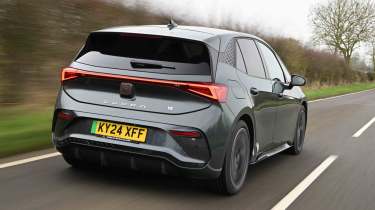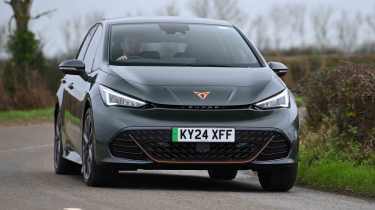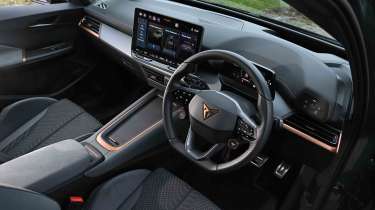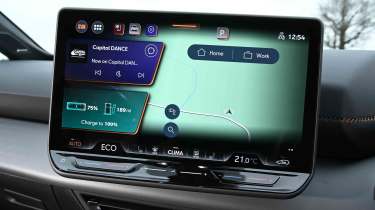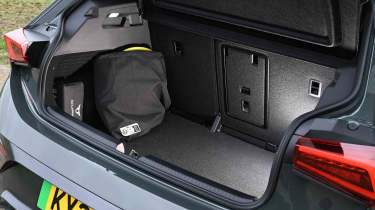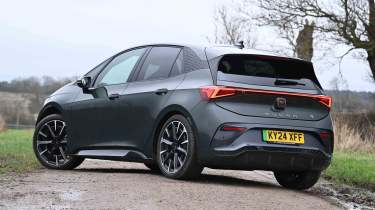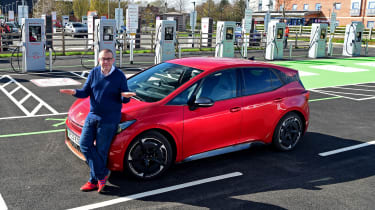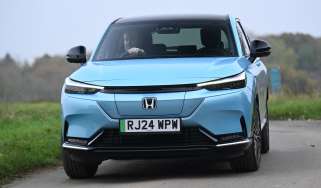Cupra Born review
Sporty Cupra Born electric hatch looks the part, and delivers a decent mix of abilities
Is the Cupra Born a good car?
It’s tricky to stand out in a class filled with so many competitive alternatives, but the Cupra Born has managed to find a smart little niche for itself. While so many of the Born’s rivals try to boost their appeal with chunky SUV design cues, the Cupra takes things in the other direction by offering a sharp and sporty look.
It rides on the Volkswagen Group’s MEB platform that’s specifically designed for EVs, and the overall proportions are determined by the fact that there is no need to package a bulky internal-combustion engine up front. The bonnet is short, which enables the wheelbase and the cabin to be stretched further towards the front. In other words, it’s the length of a regular family hatchback, but offers more interior space.
| Key specs | |
| Fuel type | Electric |
| Body style | Five-door hatchback |
| Powertrain | 59kWh battery, 1x e-motor, rear-wheel drive 77kWh battery, 1x e-motor, rear-wheel drive 79kWh battery, 1x e-motor, rear-wheel drive |
| Safety | Five stars Euro NCAP (2022) |
| Warranty | Three years/unlimited miles |
How much does the Cupra Born cost?
With a line-up starting from around £36,000, the Cupra Born is one of the better-value routes to new EV ownership. And for the money you get a decent five-door hatchback with a fair amount of space inside for the car’s size, while the battery options have quoted ranges between 260 and 370 miles.
The entry point to the line-up is the V1, which comes with a 59kWh battery and offers 264 miles of range. An extra £1,800 gets you into a V2 model with the same battery, while V3 trim is roughly £1,800 on top of that, but has a shorter range, at 259 miles. The V3 model can be had with a larger 77kWh battery for an extra £2,800, and this model can travel up to 342 miles between charges according to the official figures. All of these models feature the same powertrain, which uses a 228bhp electric motor that drives the rear wheels.
Used - available now
At the top of the range, the Born VZ costs around £45,000 and is as close as you’ll get to a hot hatch, because power is cranked up to 321bhp – although the car is still rear-wheel drive. The VZ also has the biggest battery at 79kWh, and has a range of up to 366 miles according to the official figures.
Engines, performance & drive
Buyers are offered three choices to tailor their Born to their own needs when it comes to power output and overall range. All versions use a rear-mounted electric motor, and in most of the range this produces 228bhp and 310Nm of torque. This is offered with a choice of two battery capacities; a 59kWh pack is available in V1, V2 and V3 trims, while the larger 77kWh unit is only offered in the V3. The 59kWh has an official range of up to 266 miles, while the 77kWh model’s is 348 miles.
Performance is great in both instances; the smaller-battery model weighs less and is therefore able to put its identical power output to better use and covers the 0-62mph sprint in 6.7 seconds – 0.4 seconds faster than the large-capacity model. The throttle response in recent models seems much more lively than in earlier Borns, so it really feels good for that performance, too.
In order to get the longest range, you have to go for the performance model. The VZ adds an extra 7kWh of energy to achieve a 372-mile range, but also gets a much beefier motor. Output climbs to 321bhp and 545Nm, lending the VZ genuine hot hatch status. The 0-62mph dash takes just 5.7 seconds, which isn’t as quick as the twin-motor versions of the Volvo EX30 and MG4 X-Power, but the Cupra is far more engaging to drive than either of them.
The Born strikes a great balance between ride and handling, which helps it to stand out among a sea of models which, at best, tend to deliver one while compromising the other. Twist the column-mounted drive stalk into D, and the Born moves away in near silence. The throttle is easy to modulate and has plenty of travel to enable smooth driving around town, and the other controls are precise. The suspension has a sophistication to its damping, which means that even though it’s a little firmer than some alternatives, it rarely crashes harshly over bumps.
Ironically, the smoothest-riding Born is the hottest VZ model. Thanks to its 15-way adjustable adaptive dampers, the ride can vary from a superbly cosseting level of comfort at one end to track-only firmness at the other. For the rest of the line-up, driving manners are well judged. Regardless of which version you go for, the Born is a hefty car – the kerbweight in some models only just dips below the two-tonne mark. Yet despite this, the low centre of mass and rear-wheel-drive layout mean it’s competent along a twisty road, with a predictable balance and little body roll.
Our one criticism is the brake pedal, which has a slightly clunky transition between motor regeneration and friction braking. The pedal initially feels quite firm, but ask for more stopping power and it then goes spongy, with extra pressure not adding much in the way of any deceleration. Whether you’re driving enthusiastically or simply trying to perform an emergency stop, it’s not the most reassuring feedback.
Thanks to its lowered suspension, uprated anti-roll bars and tweaked steering, the VZ is the sharpest Born to drive. And for the price, it’s one of the most engaging EVs around. However, the VZ isn’t quite as much fun as a 321bhp rear-wheel-drive hatchback sounds on paper. We’d like Cupra to show a little more courage and allow the stability and traction-control systems to let the driver play with the car a little more, because fundamentally, there’s a lovely balance to the chassis, which gives you the confidence to push hard.
Comfort and stability are the name of the game in the Born at motorway speeds which, combined with a potential for an excellent cruising range, makes it a very capable long-distance car. We’d like road noise to be slightly less audible; however, tyre roar is always more conspicuous in an EV when compared with a petrol or diesel car, where engine noise tends to drown it out. But even so, the Born suffers from these effects more than rivals such as the Kia EV3.
| Model | Power | 0-62mph | Top speed |
| Born V1 59kWh | 228bhp | 6.6 seconds | 99mph |
| Born V3 77kWh | 228bhp | 7.0 seconds | 99mph |
| Born VZ 79kWh | 321bhp | 5.6 seconds | 124mph |
Range, charging & running costs
An efficient powertrain is a big plus point with the Cupra Born, but it’s a shame that buyers needing a long range must fork out for the most expensive models.
Officially, the Cupra Born can charge at up to 185kW in VZ trim, which is among the fastest speeds of any car in its class. To achieve this, the battery needs to be at its perfect temperature, and this can be initiated easily through a simple optimiser mode in the infotainment menu. Doing so also provides an accurate estimation of potential charge speeds regardless of the battery’s current state.
With the battery in its ideal condition, we achieved 185kW up to about 30 per cent charge, tailing off to around 155kW by 50 per cent and 85kW at 80 per cent. Smaller-battery models charge slightly more slowly. However, the respective 165kW and 175kW speeds of the 59kWh and 77kWh models are still excellent.
In temperatures ranging between freezing and 10 degrees Celsius, we averaged 3.3 miles/kWh when testing the top-spec Born VZ, which translates into a real-world range of 261 miles. We have previously run a Born (with the marginally smaller 77kWh unit) on our long-term fleet, and even on long motorway runs, warmer temperatures lifted its overall range to beyond 300 miles.
Electric vehicles have been exempt from the Expensive Car Supplement that is added to the VED rates of cars priced at more than £40,000, but that will change from April 2025 onwards. As a result, private buyers of the higher Born trim levels can now expect to pay £620 road tax from the second year.
The entry-level Born equipped with the 59kWh battery starts at insurance group 26, with bigger-battery models and higher trim levels rising to 28. The sporty VZ model is the most expensive of the range to insure, and is in group 34.
Compared with some rivals, the Born holds its value quite strongly. Depending on trim level, after three years of use it should retain between 44 and 49 per cent of its original price, according to our sources at CDL VIP. While that’s well above several Stellantis EVs, it’s not quite as strong as the Kia EV3’s residual values.
| Model | Battery size | Range | Insurance group |
| Born V1 59kWh | 59kWh | 266 miles | 26 |
| Born V3 77kWh | 77kWh | 348 miles | 28 |
| Born VZ 79kWh | 79kWh | 372 miles | 34 |
Design, interior & technology
Copper highlights, a sporty-looking steering wheel and interesting dashboard textures give the Born a unique look. Except for some fiddly touch-sensitive sliders, the climate controls are all adjusted via the central touchscreen. The on-screen set-up is a big improvement on early cars, but we’d still rather have proper buttons.
Fit and finish inside are pretty solid all round. While the Cupra is not quite as outstanding as a Peugeot E-308 in these areas, it feels more expensive than many other competitors at this price point.
The Born VZ comes with a Sennheiser audio system as standard, which is optional on the rest of the range. The set-up tries to give the sense of a surround-speaker set-up by separating certain frequencies and playing them from different locations in the cabin.
You can adjust the strength of the effect, which is a good thing because it occasionally does odd things to the music. On some occasions, we noticed that it split the drum track between front and rear, so it sounded like someone was just lightly tapping the dash along to the song.
Sat-nav, stereo and infotainment
We criticised early versions of the Born’s infotainment, and rightly so – initial set-ups had one or two baffling menu structures and we found them to be full of glitches. The latest models featuring Cupra Connect are a vast improvement, though.
The main menu layout is logical, and shortcuts make it easier to switch off the driver-warning bongs. The climate control temperature settings are a permanent fixture on screen, which makes life easier, but we’d prefer buttons.
The 5.3-inch digital driver’s display presents only the essential information to avoid unnecessary distraction, and it adjusts with the steering wheel, so it’s always positioned in just the right place for it to be viewed clearly.
Boot space, comfort & practicality
From the driver’s seat, the Born’s deep windscreen and small A-pillar quarterlights give the same feel of sitting at the wheel of an MPV. It does make it hard to judge where the bonnet ends, although the very short front means you can squeeze the nose into smaller spots than you initially realise.
There’s plenty of adjustment for the driver’s seat and steering wheel in all versions of the Born, while the upgraded Sabelt seats in the sporty VZ model are superb. They offer excellent support when cornering, while remaining comfortable on longer trips, too.
Thanks to a high centre console, which is more or less entirely dedicated to storage, there’s plenty of space to hide various items away. This area manages to compensate for the Born having a small glovebox.
A short bonnet and fairly long wheelbase help deliver plenty of cabin space given the Cupra’s relatively compact footprint. While slightly taller alternatives, such as the Hyundai Kona Electric and BYD Dolphin, offer a little more rear legroom, the Born is above average for the segment, and passengers benefit from more shapely and supportive seats than in either the Kona or Dolphin, too.
Headroom is fine for six-footers, although large C-pillars make things feel a little more gloomy in the back than in some rivals.
With a volume of 385 litres, the boot is perfectly usable. It’s a shame that the lip is fairly high, though, and the cut-outs for the angular tail-lights make for some fairly jagged edges on the door. Unlike some rivals, the Born doesn’t have a front boot, so if you need to bring a charging cable with you on a long trip, it’ll need to be packed alongside any luggage or shopping you’re carrying.
| Dimensions | |
| Length | 4,322mm |
| Width | 1,778mm |
| Height | 1,540mm |
| Number of seats | Five |
| Boot space | 385-1,267 litres |
Safety & reliability
Euro NCAP awarded the Born a five-star safety rating when it was assessed in 2022. Every model in the line-up has adaptive cruise control, forward-collision warning and autonomous emergency braking, lane assist and traffic-sign recognition.
Cupra finished an underwhelming 18th out of 32 brands in our 2024 Driver Power customer satisfaction survey, and it’s clear where owners were least impressed; the brand ranked bottom of the pile for the intuitiveness of its infotainment systems, and 31st out of 32 manufacturers for the design of its climate-control functions. Hopefully the improvements made to the Born will help to lift these scores
Cupra offers a five-year/90,000-mile warranty as standard across all of its model range. This is two years and 30,000 miles longer than the warranty cover offered by SEAT, although rival Hyundai has an unlimited mileage cap on its five-year warranty, while Kia offers a seven-year/100,000-mile warranty.
The all-electric Born also gets a separate eight-year, 100,000-mile warranty for the battery pack. Both warranties are transferable to subsequent owners, too.
As with most brands, Cupra offers the option for drivers to sign up for a service plan on its new models. The most comprehensive of these costs around £520, and given that it only runs for two years, it’s pricier than plans offered by rivals.
| Key standard safety features | Euro NCAP safety ratings |
|
|
Cupra Born alternatives
The Born is the mechanical sister car to the Volkswagen ID.3 hatchback, although we prefer the Cupra because of its sportier personality and slightly larger standard infotainment screen, plus it feels better resolved to drive on UK roads. The Renault Megane E-Tech is another key rival. It can offer a range of around 280 miles on a charge, so can’t match certain versions of the Cupra, but the all-electric Renault is more practical and features one of the best infotainment systems in any new car. Another option is the Kia EV3, which is more SUV-like in its design, plus it has a softer chassis and a longer range.
Another major player is the MG4 EV, which is surprisingly fun on a twisty road, yet it is still spacious, refined and practical. More importantly for some buyers, it costs several thousand pounds less than the Cupra – while an entry-level MG4 is considerably less, starting at around £27,000. Even the top-spec MG4 XPower is only around £37,000, although it’s not as fun or as engaging to drive as a Cupra VZ.
Cupra Born 77kWh V3 long-term test
Former Editor-at-large, John Mcllroy, ran a Cupra Born for six months in 2023 and covered a little over 5,000 miles in it. He completed mostly urban journeys, but did endeavour to take it on a long family holiday and a few extended day trips, where John found the range to be perfectly usable, leaving him in no doubt that the 77kWh battery pack was more than enough for family life.
What was more frustrating during his time with the car was the scheduled charging function that didn’t work. This is an important feature for any EV driver on an electric-car-specific home electricity tariff to take advantage of cheaper rates, but John had to manually do this with an app on his phone rather than rely on what he’d programmed into the car touchscreen.
Frequently Asked Questions
Unlike other marques in the VW Group, Cupra’s new-car warranty lasts for five years or 90,000 miles, whichever comes sooner. In addition, the warranty is transferable to subsequent owners. The Born’s battery is covered for eight years or 100,000 miles and will be replaced if it drops below 70 per cent capacity.





